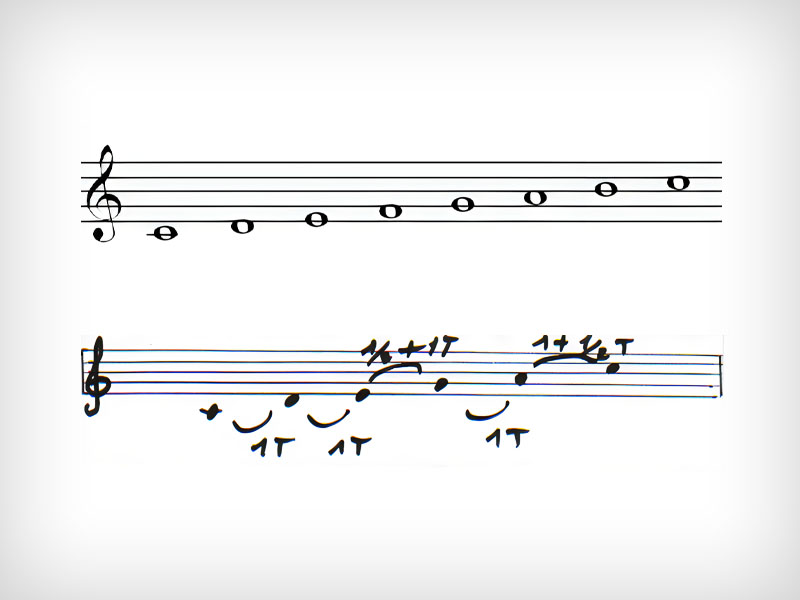The quintet key in the African music
Issue 6

Abdelqahar Alhajjari - Morocco
The secret beneath this musical singularity stands in the thinking of the African man and his life from the cradle to the grave. It is linked to happiness and grief, and he exercises it with passion in social events like wedding, birth, circumcision, death, and protest movements. Music and dance have formed a mean of resistance against the apartheid regime of South Africa. Music intervenes in the spiritual rituals, traditional therapy, and the struggle with evil spirits. African drums and many instruments have coexisted since ancient times. Dancing was always an effective and dynamic pattern of African life, rituals of fishing, advocacy for the war, love, marriage, work, and exercise. The expansion of the musical phenomenon at the African people can be explained through an idea, simple in form but deep in meaning, which says that music is life. The researcher deals with the quintet key as a characteristic of the African music whose effects have been extended to the world. It constitutes a musical material in common with the Moroccan and Arabic music and the music of the people of Eastern Asia. The researcher approaches the quintet key from the standpoint of theoretical music through the identification of the terminological significance of the quintet key ‘Pentatonic’, analysis and identification of all the quintet key levels and dimensions, derivation of its scales, remodeling, comparing it to the sevenfold key, and identification of the most important musical instruments used in Africa, related to the quintet key in the north Africa. The researcher refers to the quintet key ‘Pentatonic’ as a key consisting of five grades taking into account in its ranking a specific system, and the origin of the Greek word is composed of three parts: “Penta” which means five and “Ton” which means dimension, from the sound distance and “ic” is a relative adjective, and the meaning is quintet voice instead of seven “Heptatonic”. The researcher analyzes the musical key known since ancient times, turned back by some researchers to the date 2500 BC in ancient Chinese music. It is found in the music of various peoples of Asia and Africa in work, social, and religious events, etc and employed in American and European music. We found it in the many templates of improvisation and singing, and has entered into the formation of the blues and jazz music in particular. It is performed by traditional and modern instruments. The quintet key has moved from Africa to America. Black African descent farmers sang at work in the cotton fields, in particular, sang using this key. As a result, the blues and jazz emerged after the end of the 19 on the basis of the quintet key. At the beginning of the twentieth century, when the creators of the blues and jazz music wanted to write notes, they submitted it to the rules of writing the completed key, namely the sevenfold key ‘Gamme Heptatonic’ (Hepta means in Greek seven). They considered the quintet key involved in the sevenfold key, but writing the quintet key pushed them to change the dimensions of the sevenfold scale, and called the readjusted degrees blues notes, and considered these notes as characteristic of the quintet key. Then they wrote a sort of the original quintet key on ‘Chromatics’, i.e. modified degrees, and called it ‘hexatonic scale’. The researcher defines the most important musical instruments in Africa, especially those designed specifically for the performance of musical phrases formulated primarily on the quintet key, including the ‘blaphone’ instrument made primarily on the basis of this key and designed in Manding tribe of Mali. It is used for therapy or to accompany women singing. It is played by men, and is sometimes accompanied by other instruments like Bongodu, a rhythm machine of the Idiophones instruments family, made of mud, and found in Africa, Latin America, and Asia. The researcher highlighted the quintet key in North Africa, where it still exists at all the peoples of the Arab countries and the countries of the Maghreb from the Red Sea to the Atlantic Ocean. In addition to the special nature of the southern Egypt music, the Egyptian Nubian music, and the Sudan, which is based on the quintet key, we also found the tone of this key in Libya, Tunisia, Algeria, and Tuareg in the south of these countries. Any student of the various popular music in the south of Morocco, especially the songs and music of Gnaoua and amazigh music in Sousse, will be aware of the tone of quintet key in singing and playing in the ‘Sousse Guenbari’ and ‘Hajhouj’ of Gnaoua.


































































